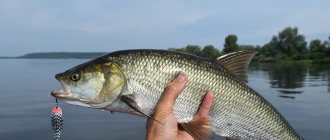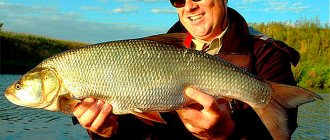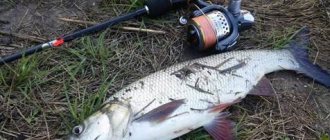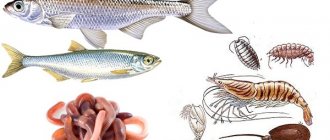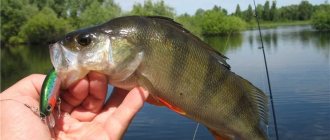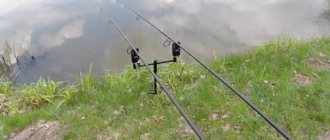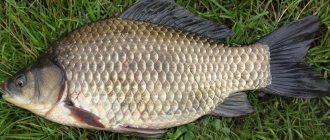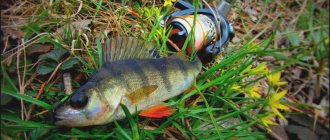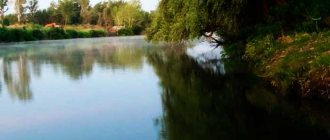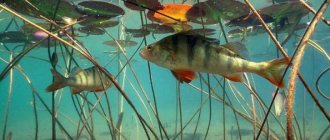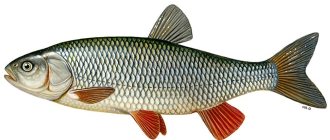Few fishermen have a trophy in the form of such a predator as asp in their records. Although fish is quite widespread in our rivers, this object of hunting has not gained much popularity among fishing enthusiasts. And this is due to some specifics in the development of fishing tactics and strategies, where the key point is the choice of method and preparation of equipment for catching asp.
It is not difficult to understand the peculiarities of asp fishing, and after familiarizing yourself with the topic of this area of fishing, it becomes obvious that most fishermen are quite capable of assembling effective equipment for asp. Our information article presented to the reader’s attention will be devoted to the issues of assembling asp gear suitable for various fishing conditions in conjunction with the selection of working and fishing baits.
Where and when to catch asp
The hero of our article, although a representative of carp fish species, belongs to the category of predators that inhabit almost all rivers of the Baltic and Black Sea basins. Asp, or as it was also called sheresper in ancient times, inhabits large rivers with moderate currents, clean and highly oxygenated waters. It likes to stay on the boundaries of mixing waters, blocking the entrances to quiet backwaters near sandy shores, spits and capes, in a unique way hunting for schools of fry.
In most cases, an actively hunting predator reveals itself with strong splashes or fights during attacks, stunning a school of small fish with powerful blows of its body, subsequently collecting the startled fish as food. Despite the size of the predator, the catches include specimens from half a kilogram to 3–5 kilograms, it is considered one of the most stubborn fighters, capable of providing serious resistance during fishing, where it often crushes unreliable tackle.
Important! The asp is cautious and stays at long distances from the shores, especially if it senses movement on the approaches to the water.
Fishing begins from the stable spring warming of the water until the first serious frosts in autumn, after which the asps move to the depths and in most cases become inaccessible to the fisherman. Bursts of biting are observed during the pre-spawning and post-spawning period in April, May and before preparation for wintering in September. These periods of the year are considered the best time to catch asp using a spinning rod.
When the asp bites: the best time and weather for fishing
The secret to a good catch has been revealed, just pour 1/4 of a slice into the water...
As you know, the asp is a predatory fish that actively hunts almost always, regardless of the season, and can bite quite intensively regardless of the time of year.
Of course, there are certain periods of time when biting activity increases significantly or, on the contrary, sharply decreases.
First of all, it is early spring (late February - mid-March), when the intense feeding of fish begins.
At this time, the biting activity can be very intense, and the asp bites best on small artificial spoons and live bait , which are suitable for small gobies, roach or crucian carp, which are good at attracting the attention of a hungry predator.
In early spring, it is a good idea to catch the predator using bloodworms, maggots or leeches. The best biting times are early in the morning (from 4 to 7 o’clock), lunch (13-15 o’clock) and evening (after 18-19 o’clock).
In summer, the intensity of bites generally decreases slightly, while the predator is most actively caught in late June to August, when the water temperature warms up significantly.
You can catch an asp using a wide variety of baits and lures, ranging from ordinary dung worms or bloodworms to bright, small spoons (wobblers, spinners, vibrotails, Devons, etc.).
In the summer, in order to more actively attract the attention of a predator, it is advisable to use spinners of fairly bright colors (silver, golden), since during this period of time the predator is not hungry and is very lazy in its movements.
In autumn, with a significant decrease in water temperature, the activity of the predator gradually increases, and somewhere in late October to early December the autumn feeding begins.
At this time, he can be attracted by absolutely any bait and lure that moves in the water, while a hungry asp can practically pounce on it very quickly without thinking.
The best autumn baits are bright, small spoons, bloodworms, leeches, worms, various insect larvae, maggots, etc.
The most catchy time for fishing is early morning (from 5 to 8 o'clock) and evening (after 17-18 o'clock), sometimes the predator bites well at lunchtime (12-15 o'clock).
In winter, the asp hunts quite often, so to catch it you can use small jigs such as “ant”, “ovinka” or “pellet”.
The most catchy winter baits can be maggots, bloodworms or small live bait (minnow, roach, crucian carp, goby, bleak, etc.).
In winter, fish bite best in the morning from about 7-8 o'clock and at lunchtime when the air temperature has sufficiently warmed up.
Asp is quite sensitive to sudden changes in weather conditions (severe cold, rain or snow), so it is advisable to always take these weather factors into account immediately before going fishing in order to get a good catch.
The fish will immediately feel on the hook if you smear it with thick...
Tackle for asp
The aggressive bites of the predator and its rapid withdrawal when taking the bait place serious demands on the gear for asp fishing in terms of reliability, but at the same time, rough equipment and carelessly assembled rigs affect the sensitivity of the gear and alarm naturally timid fish. In practice, asps are caught using both artificial and natural, mostly animal, bait, so the type of gear for catching fish can be very diverse. We present an overview of the main and most popular gear in the further part of our educational material.
Spinning tackle for asp

Classic asp fishing involves catching a predator with a spinning rod using a lure. When equipping a spinning rod for an asp, choose a long-range rod of 3-3.3 meters with a parabolic action, with a test range from 20 to 40 grams. It is desirable that the form be equipped with reinforced rings of large diameter. This nuance has a lesser negative impact on the casting distance and in a scope with a parabolic spinning blank, which absorbs jerks and the force of the initial blow, it contributes to the reliability of vigorous fishing for powerful fish.
The rod is equipped with a high-speed spinning reel in the size of 3000-4000 units with the ability to fine-tune the friction brake, the spool of which is charged with a thin braided cord 0.15-0.18 mm in diameter with a reserve of 100-120 meters. Since the predator does not have teeth, leashes are not included in the equipment and baits are tied directly to the cord.
Bombard
Recently, more and more asp fishing enthusiasts have switched to hunting for asp using a bombard. The float allows you to deliver small and light baits over fairly long distances, which, of course, helps to catch cautious and wary fish. For fishing, they select fishing rods specialized for sbirulin from 3.5 to 4 meters in length, equipping them with a spinning reel identical in parameters to the device used in spinning fishing, which we told the reader about a little higher.
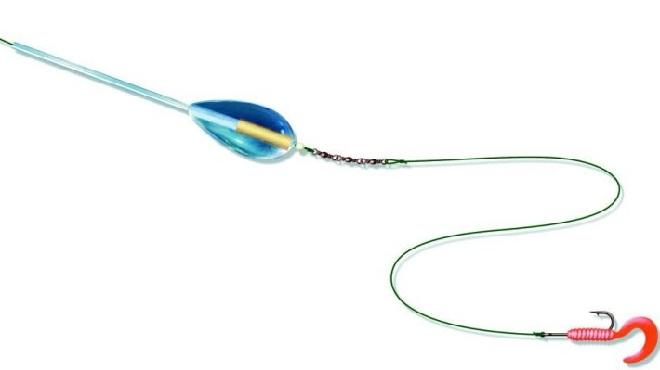
The main braided cord is complemented by a fluorocarbon leader 0.2-0.25 mm thick, ending with a bait. The distance from the bombard to the bait, or rather the length of the leash, is taken to be at least one meter. The wiring horizon is determined by the mass and type of special float.
Float tackle
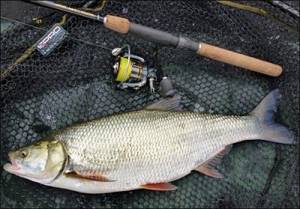
For long-distance fishing, Bolognese rods 6–7 meters long are used for fishing. When fishing in calm currents and backwaters, the fishing tactics will be completely satisfied with match gear. Lightweight and flexible fishing rods made of carbon fiber for dynamic fishing are the most suitable option for asp hunting, without tiring the angler from frequent casting. Inertia-free reels are equipped with monofilament lines with a diameter of 0.2-0.3 mm in the color of water. When fishing with Bolognese tackle, pea-shaped floats are used, which are less alarming to the fish. For matches, spindle-shaped signaling devices weighing no more than 10 grams are used. The shipment is made with a garland of spaced pellets, which increases the delicacy of the equipment. At the end of the installation, thin monofilament leashes with a length of 30–50 cm and a diameter of 0.12–0.14 mm are installed. Hooks are used in the color of the bait, most often using numbers 8–10.
Fly fishing tackle for asp fishing
Fly fishing is promising during periods of mass emergence of insects at the end of the spring and beginning of the summer season. They intensively collect all kinds of high-calorie mayfly, which is a favorite delicacy of asps, from the surface of the water, getting carried away by the process of free feeding and losing the vigilance usually characteristic of fish. For fly fishing equipment, a specialized rod with a fast or medium-fast action is used, equipping the inertial reel with a torpedo-shaped cord with a short head.
They are caught on fast currents in areas adjacent to underwater vegetation or tree crowns hanging over the water. Most often, baits are floated downstream, casting at 45 degrees relative to the flow of the stream.
Where to look for asp?
It is not very common in our country. It lives only in the Black Sea and Caspian Sea basins. It prefers medium and large rivers - it can hunt both in creeks and on the current, but it prefers to rest in quiet places. Unlike pike, it loves active hunting for prey. A toothy predator stands in the middle of algae or behind a snag, waiting for a suitable fish to be nearby so that it can make one sharp jerk and feast on it. But the asp chose a different tactic. Swimming through a body of water, moving from pools to currents, it looks for prey, after which it chases until it catches it. Therefore, spinning for asp is the best choice of equipment.
He often hunts on rifts and rapids, however, he loves both the main stream and places near it. Here the water raises turbidity, introducing insects to small fish. The asp loves such places - here he feasts on suitable prey. It prefers warm water, so it rarely goes into pools. It is most active in the middle layers and even higher. Sometimes it likes to “sunbathe” while swimming on the surface - an observant and quiet fisherman will easily notice it by its dorsal fin protruding from the water.
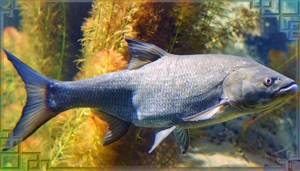
Not active at night. During rain, when other fish happily grab any bait, the asp also does not bite. In the morning he cheerfully splashes in the river, eating whatever fish he can catch. During the day there is a lull - if the asp swims only for his own pleasure, it is difficult to seduce him with bait. But in the evening he goes out to the nearest reach to have fun - he chases the fry, often causing schools of small fish to fan out from the water.
To learn more:
Top 5 best wobblers for asp
What to catch asp with
Having figured out how to assemble tackle for an asp with your own hands, let’s move on to considering the most effective baits for catching this predator. It is worth noting that the small asp does not disdain plant baits, often falling into the by-catch of floaters, coveting sweet corn and even bread. Large fish are guided by the prey of fry and therefore most often to catch trophy asp they use live bait and artificial baits that imitate insects or small fish. The predator is not afraid of flashing baits, but rather, on the contrary, they arouse increased interest in him. Therefore, glimpses of the bodies of imitators and their shiny plumage can bring greater fishing success.
Fishing methods
Spinning - allows you to use a wide variety of artificial baits that imitate the movement of live fish, forcing the predator to attack.
Fly fishing - live and artificial baits are used to attract asp; this fishing method is simple and involves correctly hooking the fish that has bitten. Fly fishing is good to use in the first half of summer, with dense aquatic vegetation in small rivers.
Donka - for this they use a regular donka or feeder rod, a worm, beetle, or live bait is hung on a hook, and the casting site can be lightly fed with large corn or peas.
Up
Spinning lures for asp
Among spinning lures, the most popular in asp hunting are small and narrow-shaped spoons that have practically no game of their own.
Important! As a rule, even a small-sized spinner weighs over 10–12 grams, which characterizes its inherent quality of long-range.
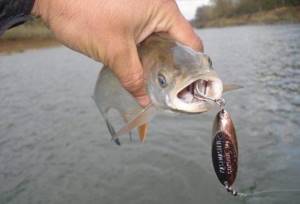
Spinning fishermen know firsthand that when fishing for asp, a castmaster spoon, placed in the predator’s battle zone and caught in its field of vision, is attacked by the fish without delay, often bringing a significant trophy in the catch. When forming an asp spinning arsenal, they focus on shapes similar to the castmaster, choosing baits no more than 60–80 mm long and no more than 20 mm wide. Rotating spinners with a narrow blade, numbers 1–3 according to the Mepps classification, are also effective in fishing. The asp likes both silver and brightly polished copper spoons.
Method of Catching Asp by Swimming
Typically used when the weather starts to get cold. The bait is hooked to a hook behind the back or mouth and led along the river bottom until the asp bites.
3 ways to improve your fish bite!
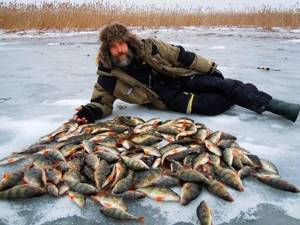
Over 15 years of active fishing, I have found many ways to improve the bite, and here are the most effective:
1. Bite activator . This pheromone additive attracts fish most strongly in cold and warm water. The Fish Hungry bite activator has proven itself to be excellent - Read more…
2. Tackle with increased sensitivity . You should first familiarize yourself with the features of using a particular type.
3. Pheromone baits . They attract the attention of fish, stimulate hunger and cause a schooling reflex, which allows you to collect a lot of fish in one place.
You can get the rest of the secrets of successful fishing for free by reading my other materials on the site.
3 ways to improve your fish bite!
Over 15 years of active fishing, I have found many ways to improve the bite, and here are the most effective:
1. Bite activator . This pheromone additive attracts fish most strongly in cold and warm water. The Fish Hungry bite activator has proven itself to be excellent - Read more…
2. Tackle with increased sensitivity . You should first familiarize yourself with the features of using a particular type.
3. Pheromone baits . They attract the attention of fish, stimulate hunger and cause a schooling reflex, which allows you to collect a lot of fish in one place.
You can get the rest of the secrets of successful fishing for free by reading my other materials on the site.
To do this, a small fishing rod should be equipped with a thin fishing line (from 0.3 to 0.4 mm) made from nylon core and hooks No. 6 or 7 of any type should be attached.
Lure for fishing with bombard
Bombarda is more suitable for fishing with artificial baits such as wobblers. Tackle with a retractable leash is capable of delivering miniature minnow-type wobblers or imitations similar in shape to a beetle or insect over long distances. The weight of such baits rarely exceeds 10 grams. They try to select colors that are similar to the natural colors of the fry, silver, blue and red colors in the style of the colors of a Christmas tree toy. In addition to wobblers, bombards are caught with turbine spinners and some types of artificial flies, knitted imitations of the cockchafer, wasp and grasshopper.
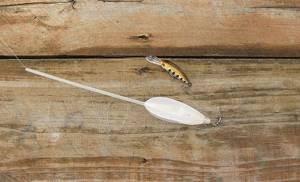
What does an asp like?
Asp, also called sheresper, loves fast flowing water . The fry and bleak eat with pleasure . It does not hesitate to eat other small fish that live near the surface of the water. Its diet includes insects (for example, dragonflies, butterflies, etc.).
Insect larvae are also the asp’s favorite “dish”.
In autumn, among other things, the sheresper feeds on frogs, which at this time find themselves in rivers.
Asp is a schooling fish . Sometimes a group of hunting fish consists of more than 50 individuals . It creates a lot of splashes. Seagulls often circle above it, looking for their prey.
But usually the hunting of a sheresper is less noticeable : a group of several individuals (for example, 5 asps) selects a stream and passes along it in the direction of the water flow, occasionally creating splashes , and then returns and descends again along the stream, collecting prey in its large mouths.
Asps are daytime hunters . At night they look for something to eat only when it is very hot during the day. As a rule, sherespers hunt close to the surface of a reservoir , but in the spring they drop lower (at this time they can even be caught with bottom tackle). This fish is particularly voracious, so the average weight of an adult is approximately 10 kg .
Lures for float rods
Such baits as cockchafer, mole cricket or locust, mounted on a hook in several large pieces, will help to make fishing tackle for asp with a float rig possible. The fishing technique with float rigs using live bait also copes well with the task of catching powerful fish. Small pieces of bleak or verkhovka are placed on the hooks. During the period of growth of frog offspring, tadpoles also look like promising bait, which can equally be attributed to a small living frog. Insects are placed on a hook, piercing the body. They try to attach the bait fish by the lips, allowing the fish to naturally move its body when floating the rig downstream. The frogs are placed on hooks by piercing the thigh.
The uniqueness of the asp
Asp, aka river pirate, aka grip, sheresper, horse, whiteness, whiteness. And he deserved all these nicknames. A pirate because he is constantly in an active search for food and it is almost impossible for small fish to hide from his rapid attack. Grip, because, despite the lack of teeth, even a relatively large fish will not be able to escape from its mouth. It received the name sheresper because it likes to spread out all its fins, and the horse because, when attacking prey, it jumps high out of the water and hits its surface with its powerful tail, trying to stun its victim. Well, whiteness and shine - for its unique color. Moreover, all these names are telling and only from them can the fisherman have a good idea of what kind of opponent he will have to fight on the rifts, near steep banks, on the current, not far from hydraulic structures and in other promising places.
You can read about the biological characteristics and habits of the asp here.
Fly fishing lures
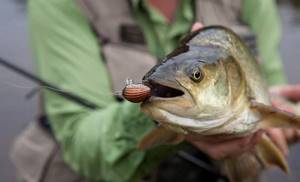
Equipment for asp when fly fishing is supplemented with both natural baits and artificial types of baits. Among natural baits, fishing with a live grasshopper or cockchafer is popular. The predator is not averse to picking up a bloodworm or dragonfly from the surface of the water. Of the artificial baits that fly fishermen are in demand for, streamers of white tones, similar in type to the body of dace or bleak, dry flies of light colors and primitive furrows are in demand. If you fish with flies on top, then with insects, streamers and imitations of beetles, you hunt in the upper or middle horizons of the water, floating the bait with the speed of the current, only occasionally giving it sluggish and non-energetic movements with a light pull in the opposite direction of the current of the stream.
Express tips for catching asp using a spinning rod in the spring
- The asp is a large, cautious predator that must be tracked in order to be caught. You need camouflage , slow and careful movements and a sufficient amount of composure so as not to rush into the hook.
- For catching asp in the spring with a spinning rod, a 3-meter rod is convenient .
- The asp quickly gets used to the bait, and it becomes uninteresting to him. Fishing stores have a huge range of baits for predatory fish. It is worth stocking up on several types: wobblers, jigs, wabs, etc.
- The fishing line should be shock-absorbing ; it’s better not to take a braided one. Asp are perfectly caught on monofilament .
In conclusion, a video about catching asp on small rivers in the spring.
Where to find asp
The habitats of a river pirate depend directly on the way he hunts. Possessing very good eyesight, in clean running water he sees a cluster of potential victims from a great distance, and this is the main condition why he not only does not like stagnant and muddy water, but simply avoids it. Therefore, asp does not live in small swampy ponds, in rivers with slow flows, peat and other banks that color the water, and where there is a thick layer of silt at the bottom.
But in wide rivers with a pronounced current, in large reservoirs not far from the flooded bed, he feels quite comfortable. But even here it is not distributed throughout the entire water area, preferring those places where the water is cleaner and more saturated with oxygen. All summer, after spawning, the sheresper robbers below the rifts, if any, on shallows with a rocky, sandy or pebble bottom, near steep banks, in eddies formed by the piles of bridges, dams and other structures, in places where flooded trees accumulate. It is here that flocks of small chubs, minnows, bleak and other favorite prey of this river pirate accumulate.
In spring, you should look for asp under branches of trees and bushes hanging over the water. Here he not only hides in the shade from direct sunlight, but also waits for a careless cockchafer, dragonfly, grasshopper or some other tasty insect to fall into the water. Sometimes he doesn’t even wait, but jumps out of the water. The speed that this fish can develop allows it to grab a low-flying insect.
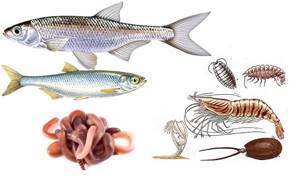
Small fish, insects, crustaceans and worms are the main food of the asp
Asp bait
It is believed that separate bait for this predator is unpromising. In addition, if he is careful, an unfamiliar smell will scare him away. Therefore, there are practically no recipes. But for a predator, the presence of animal ingredients in complementary feeding is necessary - meat, chopped worms, maggots. This is mixed with a grain base in the form of porridge and placed in the feeder. You should not bait without using a feeder.

Parking places
Most often it lives in large rivers, lakes and reservoirs. It enters small rivers and reservoirs, but does not conduct its usual hunt for fry there. And he prefers to hunt not from ambush, but by catching up with prey. The “asp fight” is also known, when the asp hits the surface of the water with its tail at speed, stunning small fish and then eating them. Such bursts can indicate the exact hunting location of the sheresper.
Does not like muddy bottoms, preferring to stay in currents with rocky bottoms. He chooses places behind some obstacle - a dam, a fallen tree. You need to pay attention to rifts and steep banks. Schools of small fish often gather near cliffs close to the water, eating insects and larvae that have fallen from the cliff. The predator also hunts fry. and on fallen insects.
